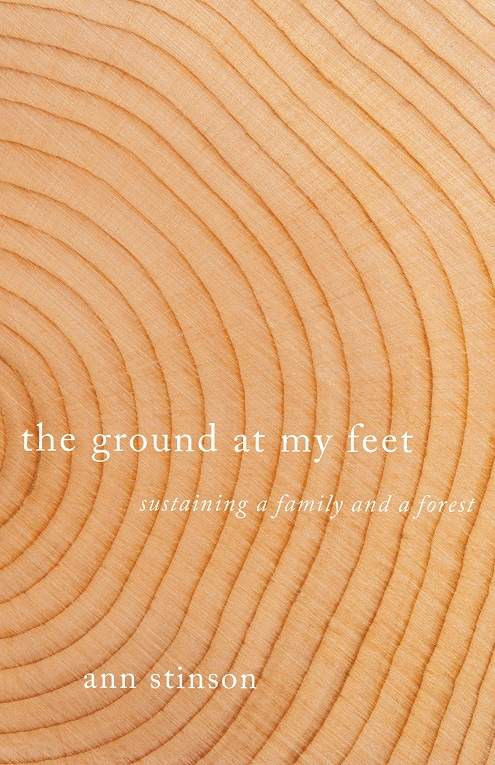by Ann Stinson
Reviewed by Melody Wilson
Oregon State University Press, 2021, 144 pages, $21.95
ISBN-13978-0870711466

Available at Annie Bloom’s and Broadway Books
When I say I love a book, maybe I mean it meets my expectations or it’s better than other books I’ve read. Maybe I mean I learned a lot without working too hard or the topic is important. But I mean it most when the book changes the way I think. All of these are true with Ann Stinson’s memoir, The ground at my feet: Sustaining a family and a forest.
I approached The ground at my feet expecting an apology for tree farming, but I was wrong on two counts. First, this family has nothing to apologize for, and second, I actually don’t know anything about tree farming. Instead, I learned a great deal about this industry from a sensitive, credible source, but I also learned about family dynamics, loss, representation, interdependence, gratitude, resilience, and love. The book is compelling from the beginning as the author and her sister-in-law spread her brother’s ashes through the family’s forest:
I pick a trailing blackberry. It stains my fingertips still coated in Steve’s ashes.
I lick them and make a fingerprint at the top of the first page of my spiral notebook.
I was relieved to see a photo of this image, as well as photos of other descriptions as we follow Stinson through her work teaching in the Bronx and in Oregon, then her decision to resign from teaching to help care for her brother and, ultimately, the farm. I read the book in two sittings and about half-way through the second sitting I began to regret that it was going to end.
The best part of The ground at my feet is its balance. Yes, I learned about forestry and logging, but I also learned a lot about how land in Washington State has changed hands all the way back to the Cowlitz and before, and how timber is marketed in the U.S., in Japan, and in Korea. I learned about workers in mills and on barges, and about the dynamics of a family that include strain and compromise but also enduring love. I gained an understanding of how stewardship actually works and what love of land looks like from the inside, about the importance of compromise and disappointment. But early on, the author quotes Wendell Berry and the lines carried me through the story:
…the world cannot be discovered by a journey of miles, no matter how long,
but only by a spiritual journey, a journey of one inch, very arduous and humbling
and joyful, by which we arrive at the ground at our own feet and learn to be at home.
It’s a broad inch and requires quite the balancing act; the world needs lumber. The land must be tended, which requires long-term management strategy. Strategies change, as do the lives of those involved. Global warming endangers trees, and farmers scramble to keep up. International conglomerates purchase local mills, and entry-level jobs are eliminated even as technology improves. Logs from the same farm wind up as fence boards in Washington, as framework for houses in Japan, for coffins in China, and massive timbers for temples in Korea.
All of this from a single farm in Toledo, Washington, tended by a single family contending with its own leaps of inches—the loss of a son, the aging of the patriarch and matriarch, and passing the land to another generation, all occurring in this century, with its anxieties and responsibilities.
Ann Stinson writes The ground at my feet with genuine humanity and without apology. Her efforts to understand her world, willingness to compromise, and willingness to learn are relentless. For example, on the journey to Korea, she has her first experience of Buddhist prayer in a temple that might well be supported by timbers from her own farm:
press hands together by the heart, bend, kneel, head to the floor, palms up, palms
down, stand. Repeat three times facing the Buddha. I like using my whole body
to pray. There is no question that I am doing something. It moves prayer out
my head and into my body, and the supplication seems to remain as I use my legs
to walk out of the prayer hall.
She is completely present, in this scene and throughout the book, and her presence leaves me with a glimmer of hope that even in industries I wish we didn’t need, there are those who think as I do and who are doing work I can’t imagine. The process is crucial and slow; it takes entire lifetimes to change and evolve. But stewardship is being passed from one generation to the next with the care that comes from understanding the continuity of the forest life-cycle, the lives of wildlife, humans, and trees, all intertwined, all interdependent.
The ground at my feet is so compelling that I resist spoiling the experience by providing too many details, but I was moved again and again––by the family, the depiction of nature, and the effort the author has put into this memoir. But I was most impressed by my own journey—from a limited understanding of the lives lived by those who work on the land to a position of empathy and curiosity. This book is not didactic; Stinson doesn’t set out to appease her reader or even to inform them. She writes her account as a gift…to the land, to [her] family…” to her father, and her brother Steve. That it is also a gift for the reader is unexpected and deeply appreciated. The ground at my feet is a beautiful account and a wonderful, informative read.
Reviewer Bio:
Melody Wilson’s recent work appears in Quartet, Nimrod, and on VerseDaily. New work will appear in Sugar House Review, Minnow, and The Fiddlehead. Reviews have appeared in Colorado Review and on OPA. Her first chapbook, Spineless: Memoir in Invertebrates (2023), was a finalist in the New Women’s Voices competition. Find her work at melodywilson.com.
